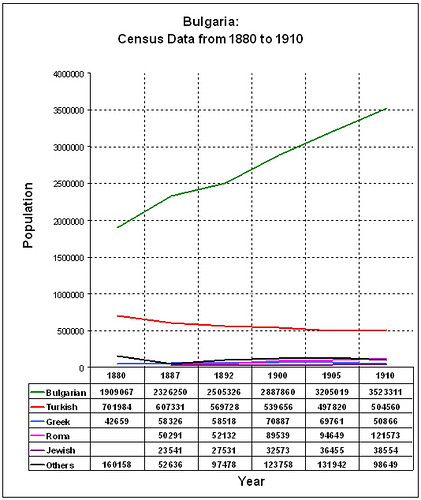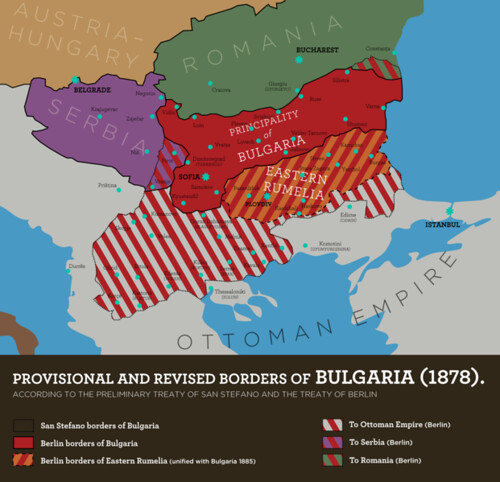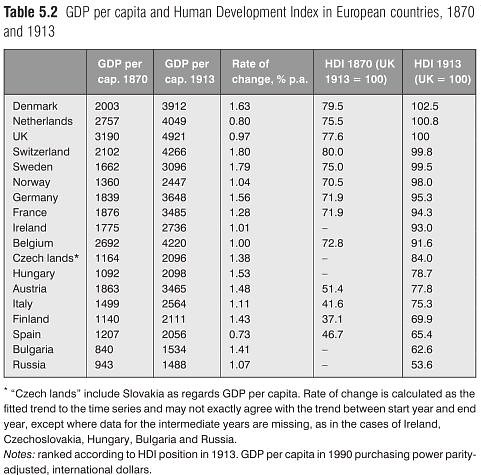Edward Hugh's essay earlier this week at A Fistful of Euros,
"The Shortage of Bulgarians Inside Bulgaria", got a non-trivial amount of attention, including linkage by
Marginal Revolution's Tyler Cowen. (See also
Economonitor which mirrors the post though not the comments, and, of course,
here at Demography Matters.) Within the European Union, Bulgaria really does constitute an exceptional case: among the poorest European Union member-states, with one of the lowest fertility rates of any European Union member-state, and with some of the highest rates of emigration, Bulgaria is quite likely because of its
rapidly shrinking population to experience the serious economic and other problems other countries are likely to experience in the near future. The country's population has fallen by a sixth from its peak in 1985, in fact.
Bulgaria has lost 582,000 people over the last ten years, a nationwide census has revealed. The EU newcomer, who has now 7,351,633 inhabitants, has lost 1.5 million of its population since 1985, a record in depopulation not just for the EU, but by global standards too.
Bulgaria, which had a population of almost nine million in 1985, now has almost the same number of inhabitants as in 1945 after World war II, the Bulgarian media writes.
The census also found that the Bulgarian population is ageing fast, that the number of young people is declining and that villages are becoming depopulated as big cities grow.
People of more than 65 years of age in 2001 constituted 16.8% of the population, while this year their rate has grown to 18.9%. At the same time, the number of children has declined, which is a clear sign that ever fewer employed people will have to provide for a growing number of elderly people[.]
Bulgaria of some interest to me in that it's a new country, in many respects newer than my Canada. Yes, Bulgarians have lived in Bulgaria for centuries without any experience of historical discontinuity as severe as that experienced by Canada, which has been almost completely repopulated by Old World migrants. Still, the Bulgarian state is a young entity: the Principality of Bulgaria was established by the Great Powers in 1878; Bulgaria was unified with adjacent and autonomous Eastern Rumelia in 1885; Bulgaria declared its independence from the Ottoman Empire in 1908; Bulgaria's current borders were only definitively settled in 1946 as the Cold War began. As much as Bulgaria is a modern European nation-state now, its history--including its migration history--bears the marks of its recent past.
1. Let's start with the migration patterns of Bulgaria's Turks and Muslims.

Taken from
here, this chart shows basic census results by ethnicity between 1880 and 1910 in Bulgaria. Noteworthy is the near-doubling of the Bulgarian population over this timeframe while the Turkish population falls by a third. The Turkish population of Bulgaria may have fallen further, in fact: one estimate in the Wikipedia article on
Turks in Bulgaria claims that in the
Danube Vilayet, which occupied most of northern Bulgaria along with parts of what are now coastal Romania, Christians of all ethnicities formed barely half of a population of almost 2.4 million people. The high proportion of Muslims in mid-19th century Bulgaria makes sense if you think of Bulgaria not as a peripheral European nation, but as a collection of provinces which formed part of the core of the Ottoman Empire, in the hinterland of the capital, even.
Muslims in Bulgaria, like Muslims elsewhere in the independent states emerging from the Ottoman Empire in the Balkans, and in the lands conquered by the Russian Empire in the Caucasus, were generally unwelcome presences in these newly Christian lands. As detailed by--for instance--Berna Pekesen in the essay
"Expulsion and Emigration of the Muslims from the Balkans", Muslims of all backgrounds--people of indigenous Balkan background like Slavs and Albanians, members of Turkic groups, and peoples of the Caucasus like the Circassians--were subjected to what would be called ethnic cleansing. Millions of
muhajir ended up settling in the Turkish core of the Ottoman Empire, starting off that country's modern
tradition of immigration. (Various estimates claim that a high proportion of Turks, some up to one-third, are descended from these refugees.) In Bulgaria's case, Pomaks--people of Bulgarian language but Muslim religion--were separated from the Turkish population by various governments, which hoped to assimilate the Pomaks into a Bulgarian ethnic identity.
Bulgaria kept a larger Turkish and Muslim population that many other Balkan countries, but towards the end of the Communist period a variety of
violent policies mandating the assimilation of all Muslims, including forced renamings and closing down specifically Muslim facilities, culminating in the May 1989 expulsion of most Bulgarian Turks from their country of birth into adjacent Turkey. The terrible international reaction and the economic consequences of the mass expulsion helped bring down the Communist government and fairly quick restitution made to the Turks (and Pomaks) as part of the democratization process. Today, Turks and Muslims in Bulgaria seem--
some concerns aside--to be well-integrated in their homeland as respected players, with their political party, the
Movement for Rights and Freedoms, being a major political player. Even so, perhaps a third of the million people claiming an identity as Bulgarian Turks
currently live in Turkey, a country where they have put down roots. The Bulgarian emigrant community in Turkey, in fact, is the largest community of Bulgarian emigrants, the half-million Bulgarians in Turkey outnumbering registered Bulgarian emigrants in the rest of the European Union combined.
2. Bulgaria's borders are not what many had hoped.

Initially in 1878 Bulgaria under Russian sponsorship would have been a large country indeed, including within its borders not only modern Bulgaria but almost all of the
historical region of Macedonia. The negative reaction of other powers to such a large Bulgaria, seen as a Russian pawn threatening Constantinople and the Straits, led to the creation of a smaller Bulgaria. Despite fighting numerous wars at great cost with the aim of gaining these territories, Bulgaria never did manage to gain more than a small piece of Macedonia. After multiple ethnic cleansings all around which saw the deportal of most of the region's Muslims to Turkey and the eventual expulsion and forced assimilation of most Slavs in an Aegean Macedonia that received many of the Greeks expelled from Turkey in 1922, and the creation in Tito's Yugoslavia of a
Macedonian national identity separate from the Bulgarian, Bulgaria was left with only a portion of eastern Macedonia. As for Bulgarian communities scattered further afield, whether in neighbouring Balkan countries or in old immigrant communities on the northern shore of the Black Sea (Moldova, Ukraine, Russia), they were left out of the Bulgarian national project.
After 1989 and the collapse of Yugoslavia, Bulgarian citizenship laws were slowly transformed so as to give people claiming an identity as ethnic Bulgarians, including those living in countries immediately adjoining Bulgaria as well as those living in the Black Sea diaspora. This was merely the most prominent part of a policy of outreach to these diasporids that includes
gifts of school books in Serbia or
vice-presidential visits in Ukraine. As
noted by Marko Žilović in an essay at the website Citizenship in Southeastern Europe, citizenship in Bulgaria--a country on track to join the European Union, no less--could be a potent economic advantage.
On a usual working day in the village of Ivanovo in Serbia there are three cars with Bulgarian license plates parked in front of the small elementary school. This is not because a delegation from Bulgaria is visiting this village of little more than 1000 inhabitants. Importing used cars licensed in Bulgaria was a well-known scheme to circumvent restrictive Serbian regulations that protect the Zastava company, the only domestic car producer. The scheme worked best if the buyer had a Bulgarian passport. It is thus no coincidence that several cars with Bulgarian license plates found their way into the Ivanovo, for it is one of the few places where fleeing Roman Catholic Slavs from northern Bulgaria settled in the 18th century. Today, about a fifth of Ivanovo’s population declare themselves ethnic Bulgarians, though probably only a handful of them have obtained Bulgarian passports. However, among the owners of the Bulgarian-licensed cars, and passports, is also a local math teacher who declares himself an ethnic Serb. He tells of having some ethnic Romanians in his family tree a few generations ago, but no Bulgarian connections whatsoever.
By far the biggest number of people claiming Bulgarian ethnic identity to get Bulgarian citizenship are from Macedonia. While Bulgaria recognizes Macedonian independence, it does not recognize the separate existence of a Macedonian nationality, leaving open the possibility for Macedonian Slavs--of which there are 1.2 million in the former Yugoslav republic--to declare themselves Bulgarians. Given Macedonia's likely continued exclusion from the European Union owing to the name dispute with Greece and an emergent history dispute with Bulgaria, claiming a Bulgarian ethnic identity makes sense. Joanne van Selm's
June 2007 profile of Macedona notes this.
It goes without saying that this is exceptionally controversial in Macedonia.
The Bulgarian case is fairly represented in Milena Hristova's February 2010 article for the Sofia News Agency,
"Bulgarian Passports for Macedonians: Debunking Myths".
Macedonians strive to obtain Bulgarian citizenship for a number of reasons – to migrate to Bulgaria, to travel and work freely across the European Union and also due to the faith in the protection that the Bulgarian state can give them.
“I would risk saying that this emotional factor is the most important and most often cited reason,” says Mandzhukova.
She vehemently denies that the real motives are more pragmatic.
“To say that Macedonians obtain Bulgarian citizenship as a passport to Europe is a stereotype that gives a very distorted reflection of the truth,” she says.
According to her the influx of Macedonians to Bulgaria did not increase significantly after the country's accession to the European Union on January 1, 2007.
“The first signs f the hype came much earlier when Bulgarian institutions agreed that the document our agency issues is enough to claim Bulgarian origin. This is when the real increase in applications came due to the streamlining of the process.”
While in Macedonia many Macedonians try to cover the fact that they have signed such a declaration.
“Well, certainly nobody will shout it at the top of his lungs. But first of all if someone considers what the Macedonian authorities think important, he would not sign the declaration in the first place, “ Mandzhukova says.
(A
April 2012 essay by the Sofia News Agency argues the Bulgaria gives Bulgarian nationality to many fewer Macedonians than Romania gives Romanian nationality to many fewer Moldovans, and is more moderate.)
The Macedonian International News Agency, meanwhile, doesn't address directly the denial of Macedonian nationhood, instead challenging via articles like
"Bulgarian citizen: Should my wife become Macedonian to get Bulgarian Passport?" (published earlier this month) the justice of a citizenship policy that makes it difficult for long-time residents to naturalize.
"Practically none of the Macedonans who have obtained a Bulgarian passport lives in Bulgaria. A large majority of them obtain the passport so they can work in EU countries. My wife on the other hand lives in Bulgaria for 11 years, speaks perfect Bulgarian, pays taxes, however is unable to obtain a citizenship" explains Bulgarian citizen Stefan Rusenov in an interview with Dnevnik.
In Bulgaria, you need to be a Macedonian so you can obtain a Bulgarian citizenship or passport overnight.
Macedonians in Bulgaria don't speak Bulgarian, they don't pay taxes here, but when it comes to obtaining our citizenship, they do it in record time, within a year - says Stefan Rusenov whose wife is from the Ukraine and is unable to obtain Bulgarian citizenship for years. According to Bulgarian laws, she would need to give up her Ukrainian passport to become citizen of Bulgaria.
- Instead of receiving a response in a year, we got our response in three years - that my wife can obtain a citizenship in three years, but, the condition was she must give up her Ukrainian citizenship. Then more problems. From the Ukrainian Embassy we were told she must register to fulfill her request of giving up her Ukrainian citizenship (which lasts 8 months), and only after that she can submit her request to give up her Ukrainian passport - explains Rusenov in frustrating fashion.
3. Bulgaria has long been a European periphery.

Taken
here, from the online version of the
second volume of the Cambridge Economic History of Europe by Broadberry and O'Rourke, this draws upon the
historical statistics of Arthur Maddison to come up with a ranking of European countries by economic and human development in the
belle époque. Of note is the fact that Bulgaria's relative underdevelopment is a fact of long-standing, one that isn't a relatively recent artifact of Communism as in central Europe. Although income and development gaps have narrowed in the subsequent century, they are still quite large. Attempts at enforcing an agricultural specialization via
Comecon's doctrine of an
"International Socialist Division of Labour" never were very successful, but neither was (for instance) the attempt to
develop a computer industry in the 1980s (
that led, mainly, to computer viruses). The catastrophic breakup of the former Yugoslavia further hit Bulgaria. Bulgaria, now in 2013 as in 1913, is one of the poorest countries in Europe.
There is an abundant literature about migration from post-Communist Bulgaria, for instance the Open Society Bulgaria 2005 report
"Bulgarian Migration: Incentives and Constellations", a 2013 fact sheet from the same organization
"Is There A Threat of Bulgarian Migration to the UK?" (quick answer: no), Fatma Usheva's 2011 thesis
"Emigration from Bulgaria: 1989 - Today", or Eugenia Markova's 2010 report for the Hellenic Observatory,
"Effects of Migration on Sending Countries: Lessons from Bulgaria". Suffice it to say that after the end of the Soviet Union, Bulgarian migrants went first to adjacent and relatively prosperous Greece, then starting to move in large numbers to Spain in the late 1990s, with Germany
recently emerging as a destination of choice. Bulgarian migrants went to places where they could find jobs easily, often in the informal sector, usually in countries that were relatively close to their homeland. Bulgarian foreign minister Nikolay Mladenov was quite right to
tell The Telegraph that Bulgarians are not especially likely to move to the United Kingdom in large numbers.
These three patterns of migration, driven by ethnic identity and relative underdevelopment, seem likely to endure. The odds of Bulgaria transforming sufficiently to not be a relatively poor country with low fertility and very high rates of emigration are not, as Edward noted, high at all. Individual Bulgarians have every incentive to continue to leave their country, and with Bulgaria's full integration into the European Union's single market in labour, very few institutional barriers. It's also fair to wonder whether Turkey, just next door with relatively strong economic growth and a recent history of receiving large numbers of Bulgarian migrants, might also emerge as a destination for Bulgarians regardless of whether Turkey joins the European Union or not. Inasmuch as Macedonia, and the adjacent countries with large Bulgarian communities (Serbia, Moldova, Ukraine)












